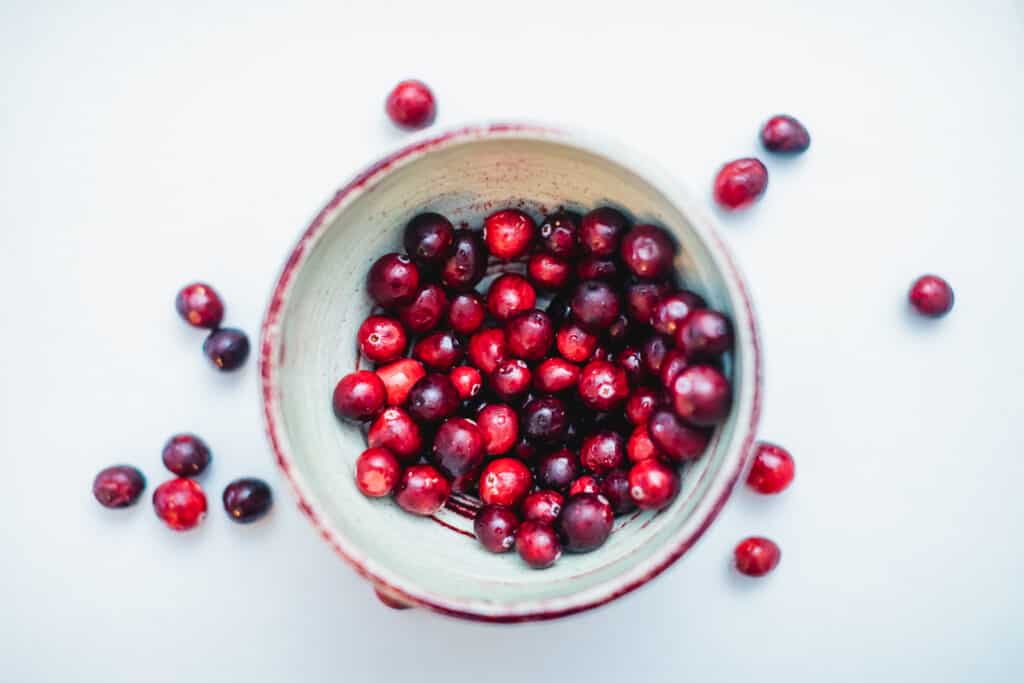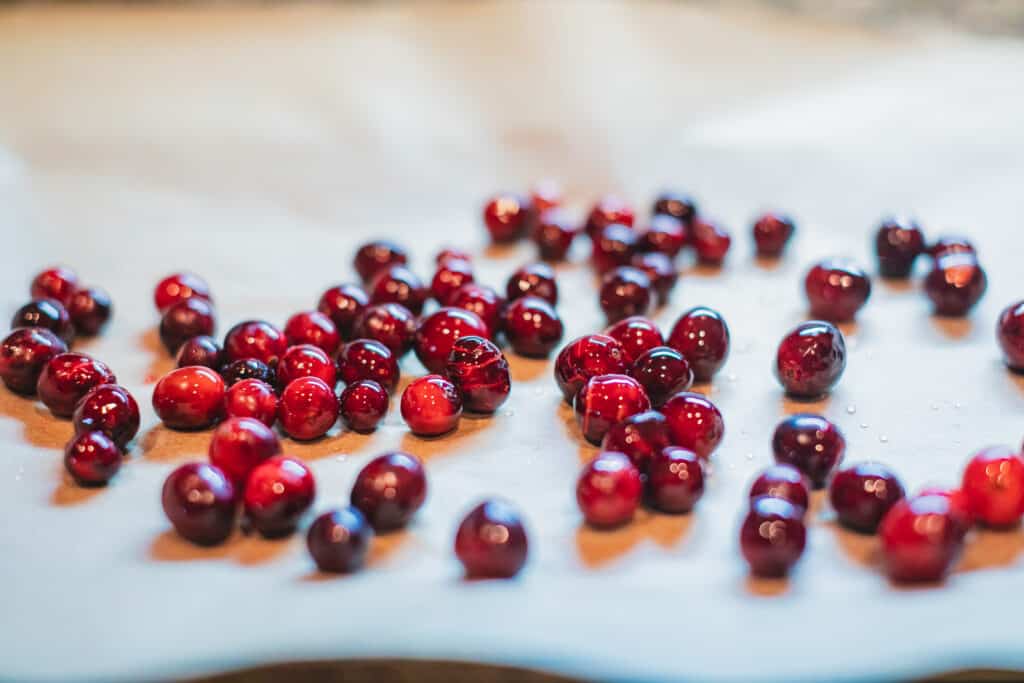As an Amazon Associate we earn from qualifying purchases.
When the holiday season comes around, I see the shelves of my local supermarkets flushed with fresh cranberries. Though, I don’t regularly buy, keep, or cook with cranberries so it can be very hard to tell if they are ripe, or worse off, spoiled. I’ll be going what identifies a cranberry as ripe so you can pick out a good batch when buying them.
Quick Navigation
What Identifies a Cranberry as Ripe?
To identify ripe cranberries, there are 3 main factors to examine: color, feel, and smell. The color should be crimson red, they should feel supple and pass the bounce test, and their smell should be very subtle.

Look at the Color
The color of ripe cranberries is crimson red to slightly maroon. Any hints of green mean the cranberry is immature. Any dark purple tones mean that the cranberries are probably overripe (but this is not a guarantee).
The color of cranberries comes from a pigment called anthocyanin. Anthocyanin develops in the skins of the cranberries when exposed to heat or cold. You have probably seen half white, half red cranberries before (every bag has them). The half white side is the side that was lower in the shade, so it stayed cooled and never developed the red color.
This means color alone is not the only factor of ripeness, and growing conditions and harvesting time can affect cranberry coloration. Want to turn your white cranberries red? Pop them in the freezer or coldest part of your fridge and watch the color change!

Examine the Firmness
To tell if a cranberry is ripe you can use the bounce test. Literally drop the cranberry on a hard surface like a cutting board and see if it bounces. Cranberries are ripe when they are supple rather than firm or soft.
Do not bounce every cranberry you want to use, just bounce a few until you find a ripe one. Use the ripe one as a guide and compare that feel to the other cranberries.
Legend has it, this discovery was an accident when a cranberry grower dropped a bucket of cranberries down the stairs and noticed differences in how they bounced down to the bottom. Whether that is true or not, bouncing cranberries has been used by commercial growers to sort cranberries, so it will work for me at home just fine.
Listen for Sound During the Bounce Test
The sound of ripe cranberries extends from the bounce test. When you bounce a cranberry it should not splat or plop. Ripe cranberries bounce and make a pretty noticeable “bong” sound when they do.

Smell Them
Ripe cranberries and under ripe cranberries smell of almost nothing. Overripe cranberries, on the other hand, will have a distinctly sweeter and fruitier smell. Importantly, this is not for the reasons you may think.
Under ripe and ripe cranberries have a very waxy skin (think like a red apple but thicker). As a result, smell barely passes through them. As a cranberry starts to spoil, the cell walls in that skin start to break down and become soft and goopy.
These soft skinned overripe cranberries can be easily damaged. You want ripe cranberries that have not been punctured or broken. So when it comes to smell, if the smell is subtle to none, it is not overripe.
Related Questions
Are White Cranberries Ripe?
Yes, white cranberries are fully mature and ready to eat. The red pigment of cranberries develops after maturity due to exposure of heat and cold.
This means those white and semi white cranberries you have in your bag are just as ready for consumption as the red ones I know and love. If you don’t want the white cranberries for aesthetic reasons, all you have to do is place them in the freezer or coldest part of your fridge for a few days and their color will turn to red.
Can I Eat Cranberries if They Aren’t Ripe?
You can eat under ripe cranberries as long as they are not green or rock solid. Chances are, in a large batch or recipe, some are going to be over ripe and some under. Most of the time you will not notice, as cranberries are so tart in their ripe state that the amount of sugar added to recipes really covers up for the difference in ripeness.
While you can eat under ripe cranberries, immature ones are a different story – if they are green or rock hard they will make for poor eating.

Should Ripe Cranberries Be Hard or Soft?
Ripe cranberries are neither hard nor soft – they are “bouncy” and “supple”. You should be able to gently push on the skin of a ripe cranberry and have it spring back up immediately.
This feel is why people often bounce cranberries to test the ripeness. If it bounces it is ripe. Just make sure you don’t bounce the whole bunch – find one and use it as a reference for feel.
Conclusion
Cranberries are an amazing source of vitamin C, fiber, and antioxidants. While they can be fantastic for cooking during the holidays they may not be very common or familiar to home cooks. As a rule of thumb, if it is mushy or sinks in water throw it out. Cranberries should be firm to spongy and buoyant in water.
